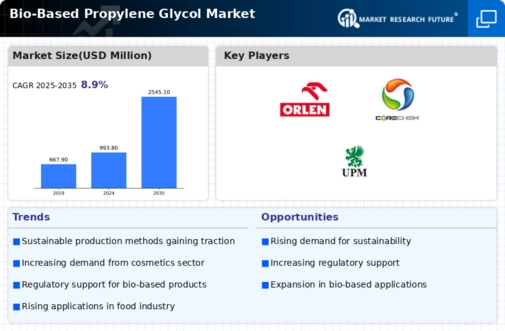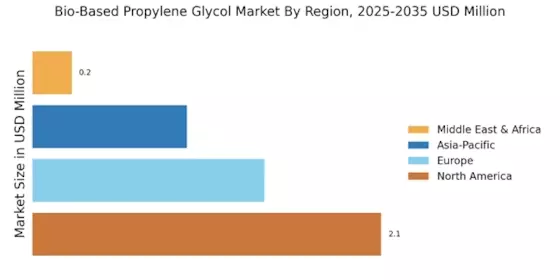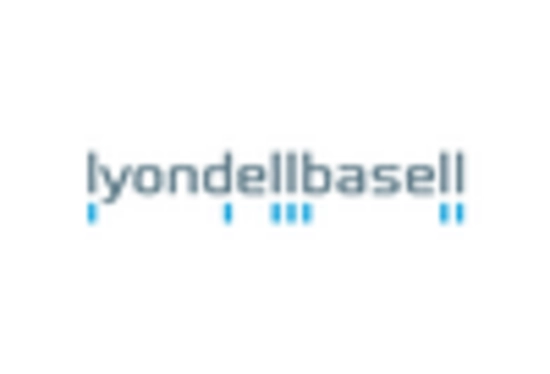Consumer Awareness
Consumer awareness regarding the benefits of bio-based products is a significant driver for the Bio-Based Propylene Glycol Market. As consumers become more informed about the environmental and health advantages of bio-based alternatives, their purchasing decisions are increasingly influenced by these factors. This heightened awareness is leading to a growing demand for products that contain bio-based propylene glycol, particularly in sectors such as cosmetics, food, and pharmaceuticals. Market data suggests that the demand for natural and organic products is on the rise, with consumers actively seeking out items that align with their values. Consequently, the Bio-Based Propylene Glycol Market is likely to benefit from this trend, as manufacturers respond to consumer preferences for sustainable and health-conscious products.
Regulatory Support
Regulatory support plays a crucial role in shaping the Bio-Based Propylene Glycol Market. Governments across various regions are implementing stringent regulations aimed at reducing the environmental impact of chemical products. These regulations often favor bio-based alternatives, providing incentives for manufacturers to invest in bio-based propylene glycol production. For instance, policies promoting renewable resources and sustainable practices are likely to bolster market growth. The market is anticipated to benefit from these regulatory frameworks, which may include tax incentives and subsidies for companies producing bio-based products. As a result, the Bio-Based Propylene Glycol Market is positioned to expand, driven by favorable government policies that encourage the adoption of environmentally friendly materials.
Diverse Applications
The diverse applications of bio-based propylene glycol are driving growth in the Bio-Based Propylene Glycol Market. This versatile compound is utilized in various sectors, including food and beverage, pharmaceuticals, cosmetics, and industrial applications. Its multifunctional properties, such as being a solvent, humectant, and emulsifier, make it an attractive choice for manufacturers across different industries. The increasing use of bio-based propylene glycol in food and personal care products is particularly noteworthy, as consumers seek safer and more sustainable options. Market projections indicate that the demand for bio-based propylene glycol will continue to rise, driven by its adaptability and the growing trend towards natural ingredients. As a result, the Bio-Based Propylene Glycol Market is expected to expand, fueled by its wide-ranging applications.
Sustainability Initiatives
The increasing emphasis on sustainability initiatives is a pivotal driver for the Bio-Based Propylene Glycol Market. Companies are increasingly adopting eco-friendly practices, which include the use of bio-based materials. This shift is largely influenced by consumer preferences for sustainable products, as well as corporate responsibility commitments. The market for bio-based propylene glycol is projected to grow at a compound annual growth rate of approximately 5.5% over the next few years, reflecting the rising demand for sustainable alternatives. Furthermore, the environmental benefits associated with bio-based propylene glycol, such as reduced carbon emissions and lower environmental impact, are likely to enhance its appeal among manufacturers and consumers alike. As sustainability becomes a core value for many businesses, the Bio-Based Propylene Glycol Market is expected to witness significant growth.
Technological Advancements
Technological advancements are significantly influencing the Bio-Based Propylene Glycol Market. Innovations in production processes, such as fermentation technology and enzymatic methods, are enhancing the efficiency and cost-effectiveness of bio-based propylene glycol production. These advancements not only improve yield but also reduce production costs, making bio-based alternatives more competitive against petroleum-based products. The market is witnessing a shift towards more efficient production techniques, which could potentially increase the availability of bio-based propylene glycol. As technology continues to evolve, it is likely that the Bio-Based Propylene Glycol Market will experience accelerated growth, driven by improved production capabilities and reduced costs.


















Leave a Comment